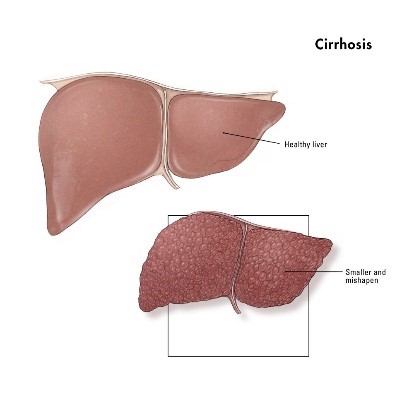Cirrhosis of the liver is a serious complication of chronic liver disease, which leads to abnormal liver structure and function. Many liver diseases cause injury and kill the liver cells, leading to scar tissue formation. Surviving liver cells multiply, in their attempt to replace the dead cells, resulting in clusters or regenerative nodules within the scarred liver. Causes of liver cirrhosis include chemicals, toxic metals, viruses, and autoimmune disease.
What Are the Symptoms of Cirrhosis of the Liver?
 Symptoms of liver cirrhosis usually do not appear until the late stages of the disease. They occur when the liver fails to detoxify the blood, to produce blood-clotting proteins, and to aid in the metabolism of fat. These symptoms include:
Symptoms of liver cirrhosis usually do not appear until the late stages of the disease. They occur when the liver fails to detoxify the blood, to produce blood-clotting proteins, and to aid in the metabolism of fat. These symptoms include:
- Decrease in appetite
- Nose bleeding
- Small spider-like arteries in the skin
- Unexplained weight loss
- Body weakness
Serious symptoms of cirrhosis include:
- Confusion
- Difficulty in thinking clearly
- Yellowing of the skin (jaundice)
- Abdominal swelling
- Edema of the legs
- Impotence
- Developing of breast tissue in males
When to See a Doctor
Call your doctor if your symptoms do not improve in one or two days, or if you have these symptoms:
- Your abdomen suddenly increases in size and you gain weight
- Increased water retention
- Persistent jaundice
- Mental or behavioral changes
- New/Different reactions to medications
- Bleeding doesn't cease
Go to the emergency department if you cannot reach your doctor when you have:
- Blood in your stool or vomit
- Severe abdominal pain
- Difficulty in breathing
- Confusion/bizarre behavior
- Fever
- Repeated vomiting
What Are the Causes of Cirrhosis of the Liver?
Liver cirrhosis is caused by the formation of scar tissue in the liver after damage has occurred over the years. The liver tries to repair itself every time it is damaged, and as scar tissues develop, liver function declines, until it no longer works well.
A wide range of conditions can cause damage to the liver, leading to cirrhosis. Some of these are inherited conditions, such as:
- Hemochromatosis, which causes iron to accumulate in the body
- Cystic fibrosis
- Wilson's disease, which causes accumulation of copper
- Biliary atresia
- Disorders of sugar metabolism
- Genetic digestive disorders
- Autoimmune hepatitis
Others liver conditions develop later in life, including:
- Chronic alcoholism
- Hepatitis B
- Hepatitis C
- Nonalcoholic fatty liver disease
- Primary biliary cirrhosis
- Primary sclerosing cholangitis
- Parasitic infection, such as schistosomiasis
Some people develop cryptogenic cirrhosis, a condition where doctors cannot find a cause for liver disease.
What Are the Treatments for Cirrhosis of the Liver?
There is no permanent cure for liver cirrhosis, but there are treatments that can delay or stop its progress, reduce damage to the liver cells, and minimize its complications.
The treatment may depend on the cause of the cirrhosis:
- For liver cirrhosis due to alcohol abuse, one must stop drinking alcoholic beverages to stop the progression of the disease.
- A person who has hepatitis may be treated with antiviral drugs or steroids to reduce injury to the liver.
- Treatment varies for people with autoimmune disease, hemochromatosis, or Wilson's disease.
Medications to control symptoms of the disease include diuretics (water pills) to reduce fluid retention. A reduction of salt in the diet is also important. Diet changes and medications can help improve altered mental functions. Laxatives may be given to increase the removal of toxins from the intestines.
People with severely damaged livers may need liver transplantation to survive.
How to Prevent Cirrhosis of the Liver
Cirrhosis cannot be reversed. However, it is important to prevent or reduce further damage to the liver by:
- Limiting alcohol intake
- Seeking help for alcohol dependence
- For non-alcoholic steatohepatitis (NASH): minimize risk by losing excess weight, controlling high blood pressure, proper diet, and control of blood sugar levels in diabetics
- Avoiding hepatitis, or getting treatment for hepatitis infection
- Avoiding contact with all toxic chemicals
- For patients with hemochromatosis: removing blood regularly through venesection to prevent accumulation of iron in the liver and in other organs
Watch the video to have a general idea on cirrhosis of the liver:
